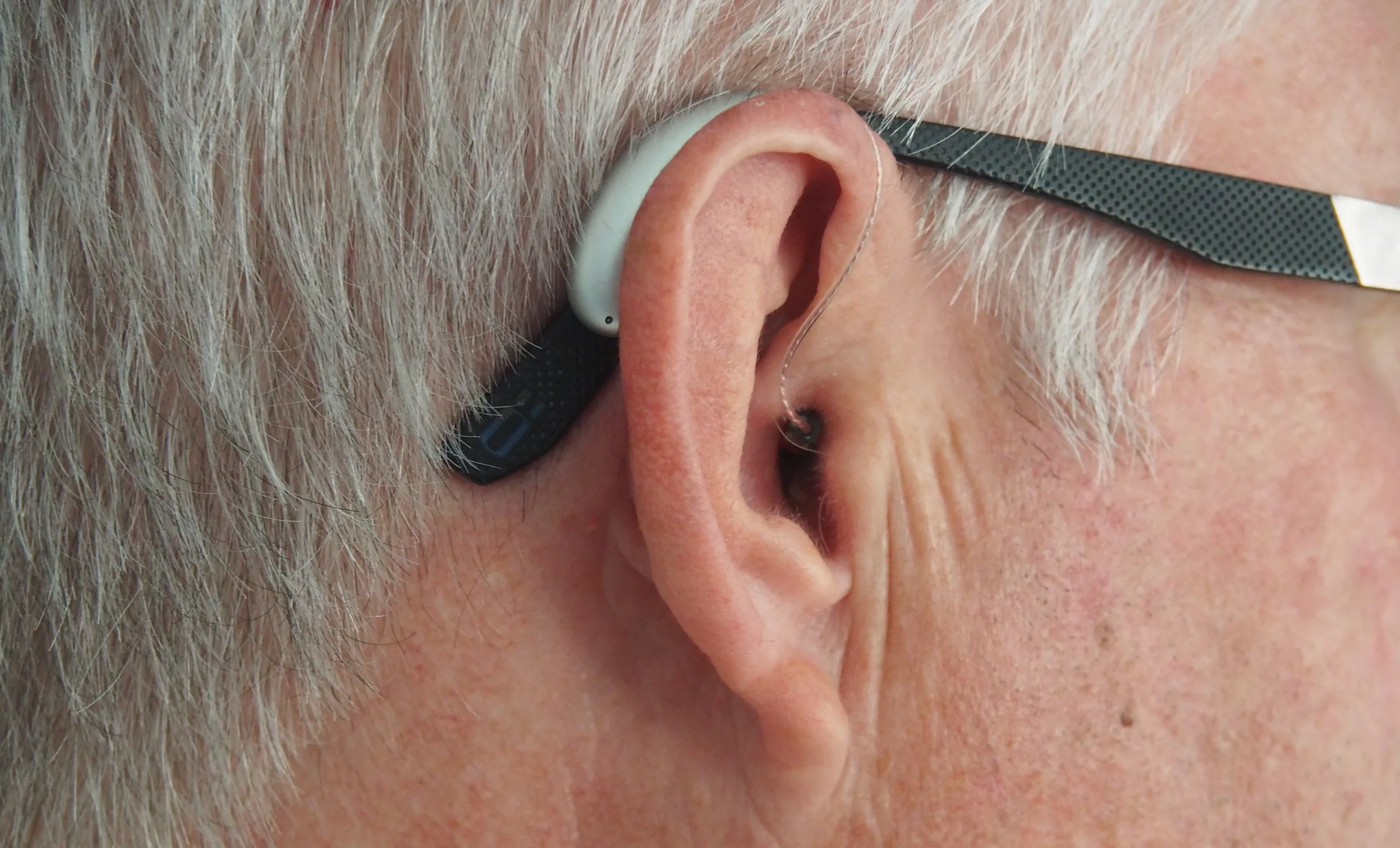Tinnitus may affect people of all ages, but may be more bothersome for older sufferers. Photo via Unsplash.
Humans rely on their senses to receive information about their surrounding environment. This ability is often taken for granted—in fact, conditions which affect hearing for example remain considerable sources of morbidity in healthcare systems across the globe. In fact, the WHO estimates that over 700 million people worldwide will have some form of disabling hearing impairment by 2050.
Tinnitus is a prevalent and bothersome form of hearing loss. Unfortunately, the mechanisms that lead to this condition remain a mystery. We know that the brain is involved in tinnitus, but we don’t fully understand how different areas of the nervous system produce the symptoms associated with the condition. Solving these mysteries may lead to the development of newer and more effective treatments.
What is tinnitus?
Tinnitus is the perception of an auditory sensation in the absence of an external stimulus. In other words, the patient hears a sound which doesn’t exist—a “phantom sound”. Tinnitus is often described as a “ringing in the ears”, yet it may present as throbbing, hissing, sizzling, or whistling. These phantom sounds are most commonly apparent in both ears, but in some cases only one ear is affected.
Globally, tinnitus affects between 10-15% of adults. After exposure to loud noises, many people experience a transient ringing sensation, which often resolves itself. This sensation persists in patients with chronic tinnitus and often reduces their quality of life. While tinnitus can affect people of all ages, evidence suggests that it is perceived as louder and more bothersome in older people for reasons currently unknown.
“There is no standard criteria for diagnosing the condition in healthcare or research”
Despite being such a common condition, there appears to be little agreement about the definition of tinnitus among researchers. This ambiguity extends beyond research, as there is no standard criteria for diagnosing the condition in healthcare settings. Since tinnitus can present as a range of different sounds, frequencies, durations, and intensities, inconsistent definitions may leave some patients undiagnosed and untreated. Having a clear definition of the condition may enable doctors to better treat patients with tinnitus who do not present with the classic symptom of “ringing in the ears”.
Risk factors of tinnitus
Tinnitus is commonly associated with hearing loss, especially age-related hearing loss. Over 25% of people aged 60 years and older are affected by chronic, irreversible hearing loss due to the degeneration of inner ear structures with age. Other conditions such as multiple sclerosis (MS), hypertension, and rheumatoid arthritis can increase the risk of tinnitus. The damage to nervous conduction in MS affects the auditory nerves which convey signals from the ear to the brain. Hypertension contributes to pulsatile tinnitus, where the auditory sensations arise due to irregular blood flow. Rheumatoid arthritis may affect hearing through the inflammation of the tiny joints in the middle ear. Even some medications, such as high doses of aspirin, may precipitate the condition.
“Phantom sounds are a stressor for patients… this can lead to a snowball effect, as stress is associated with more intense phantom sounds”
The constant auditory sensations can be quite debilitating, as sleep disturbances and depressive symptoms often result. The phantom sounds are a significant stressor for patients. This can lead to a snowball effect, as stress has been associated with an increase in intensity of the phantom sound. Although researchers are unsure if stress itself can cause tinnitus, some patients have reported that stressful events gave rise to their condition.
Genetics of tinnitus
Recently, the genetics of tinnitus have been examined based on data from the UK Biobank. The UK Biobank is one of the UK’s largest databases for genetic research, comprising health and genetic details from 500,000 participants. The information from the database is used to help us understand the genetic factors behind diseases and has linked 13 genes with tinnitus development so far. A particularly strong association was found between tinnitus and variants of the WD Repeat Containing Planar Cell Polarity Effector (WDPCP) gene. This gene seems to be expressed in a brain area called the dorsal cochlear nuclei. This area is part of the cochlear nuclei, which are the first brain areas to receive signals from the ears when a sound is detected. WDPCP is speculated to make some people susceptible to tinnitus by altering the early development of the dorsal cochlear nuclei.
Neuroplasticity in tinnitus
Recent research developments have furthered scientists’ understanding of this condition. For many years, researchers believed that overactivity in the auditory nerves caused the phantom auditory perceptions. However, animal and human studies seemed to contradict this idea. Experiments involving cutting the auditory nerves or giving drugs that damage cells in the ear reduced auditory nerve activity but did not improve tinnitus.
Scientists now believe that the brain produces the auditory sensation experienced in tinnitus. Studies have shown that changes in the brain can lead to overactivity in regions associated with hearing. The cause of this overactivity may be too much excitation or too little inhibition in these areas via changes in the levels of specific neurotransmitters. For example, studies in guinea pigs suggest that high levels of the brain’s major excitatory neurotransmitter, glutamate, might be involved. On the other hand, low levels of the brain’s major inhibitory neurotransmitter, ɣ-aminobutyric acid (GABA), may disinhibit certain brain regions.
Although understanding the role of the brain in producing tinnitus was a major development in the field, the details of these neural changes are not well understood. Many brain areas are involved in hearing, and it is not known which are involved in tinnitus. Spontaneous activity has been identified in regions such as the auditory cortex and dorsal cochlear nucleus in animals. The auditory cortex is mapped according to sound frequency, with some areas responding to low-pitched sounds and others to high-pitched sounds. As hearing loss leads to sensory deprivation of certain frequencies, the auditory cortex responds by increasing the activity of regions encoding frequencies adjacent to these understimulated areas. This may produce the perception of sound. In other words, the “ringing in the ears” that patients perceive may actually be caused by a “ringing in the brain”.
Despite this, other studies have shown that changes in auditory cortex activity are not required for tinnitus. Functional magnetic resonance imaging (fMRI) has allowed researchers to look at the frequency map in the auditory cortex. However, there were no significant differences between the frequency map of healthy subjects and patients with tinnitus. As a result, auditory cortex remapping may not be the only mechanism which can lead to phantom auditory sensations.
The interactions between the ear and brain that contribute to tinnitus appear to be complex. It has been suggested that dysfunction in the cochlea (the inner ear) leads to spontaneous activity in the auditory brain network. However, this is not so straightforward. Some cases of tinnitus require inner ear signals to elicit changes in brain activity, while other cases retain the auditory perceptions even when the cochlea is destroyed. The factors which determine the importance of the ear in generating phantom sounds remain a mystery.
The role of non-auditory brain systems
Another crucial development in trying to unravel the tinnitus mystery was the identification of changes in brain regions not commonly associated with hearing. For example, positron emission tomography (PET) scans show increased limbic system activity in tinnitus patients. The limbic system is the part of the brain involved in emotional regulation, and there seems to be increases in specific limbic system regions associated with tinnitus. For example, the ventromedial prefrontal cortex (the area associated with unpleasant auditory sensations) and the nucleus accumbens (the area associated with reward and motivation) have both been implicated in the condition. Although the interactions between the auditory and limbic systems remain unclear, researchers have proposed that they work together to suppress internally-generated auditory perceptions, like those experienced by tinnitus patients.
Tinnitus is often compared to phantom limb pain—a condition that affects amputees and causes painful sensations without an outside stimulus. These sensations are felt as if they originated from the amputated limb and are believed to be a result of the brain reorganising its map of the body. Likewise, tinnitus is strongly associated with hearing loss at particular frequencies, creating a phantom auditory sensation as the brain reorganises its map of sound frequencies. Further similarities are seen in terms of the brain regions involved as both conditions activate the anterior cingulate cortex, insular cortex, and amygdala. These areas play a role in memory formation and may contribute to the persistence of the phantom perception as an unpleasant emotional memory.
A recent paper published by researchers in Oxford found spontaneous activity in tinnitus at brain regions associated with non-rapid eye movement (NREM) sleep. The authors propose that this may explain the link between tinnitus and disrupted sleep, as the high activity in these regions may interrupt NREM sleep and wake the patient. Nevertheless, scientists continue to discover new brain areas with altered activity in tinnitus patients and animal models. Understanding how these changes are linked to the condition, and how this knowledge can be used to develop novel therapies remain challenges in the field.
The implication for current and future therapies
Standard treatments for tinnitus include device-based treatments and psychological therapies. Sound amplification devices are recommended by the National Institute for Health and Care Excellence (NICE) for patients with hearing loss and tinnitus. Meanwhile, cognitive behavioural therapy (CBT) may help reduce the distress caused by tinnitus, as can medications to treat depressive symptoms. That said, evidence suggests that these therapies do not lead to change in the ringing sensation itself, only other psychological symptoms associated with the condition.
There are no medications that directly treat tinnitus, although several drugs have undergone trials. Although they provide benefit in mouse models, drugs like memantine, which block the receptor that glutamate binds to, have not been proven effective in humans. Alprazolam is a drug used to treat anxiety and panic disorders by activating GABA receptors and increasing inhibitory transmission in the brain. Trials have been conducted for its use in tinnitus, although scientists are still unsure about what benefit it may provide.
There has been great progress in tinnitus research in recent years, opening up promising avenues for the development of medications and other treatments. Scientists have begun to uncover the role of specific brain regions which contribute to the formation of these phantom sounds. Further investigation may lead to possibilities for novel treatments. In particular, addressing the balance between excitatory and inhibitory signals in the brain may alleviate some of the symptoms that impact the daily lives of tinnitus patients. Although there are many mysteries left to resolve with regards to tinnitus, we can be hopeful that therapies for this highly prevalent and troublesome condition will one day improve.





